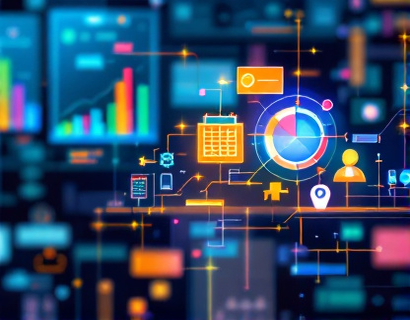Maximizing Global Connectivity: Innovative Distributed Network Solutions for Enhanced Efficiency and Security
The advent of distributed network technologies has ushered in a new era of global connectivity, operational efficiency, and security. As businesses and tech leaders strive to stay ahead in the rapidly evolving digital landscape, the need for robust and innovative network solutions becomes increasingly critical. This article delves into the transformative potential of advanced distributed network solutions, exploring how these technologies can drive digital growth and collaboration while ensuring enhanced security and efficiency.
Distributed networks, by their very nature, spread computational tasks and data storage across multiple nodes, rather than relying on a centralized server. This decentralized approach offers several advantages, including improved fault tolerance, reduced latency, and increased security. In a traditional centralized network, a single point of failure can bring the entire system down, whereas distributed networks can continue to function even if some nodes fail. This resilience is crucial for businesses that require uninterrupted operations and data integrity.
One of the key benefits of distributed networks is their ability to enhance operational efficiency. By distributing tasks and data across a network of nodes, these systems can process information faster and more effectively. For instance, in a content delivery network (CDN), data is cached on multiple servers worldwide, reducing the distance data must travel and thus lowering latency. This results in faster load times for users, improving the overall user experience and enabling real-time applications such as video streaming and online gaming to function seamlessly.
Security is another paramount concern in the digital age, and distributed networks offer significant advantages in this area. Traditional centralized systems are often targeted by cyberattacks, as they present a single, attractive target for hackers. In contrast, distributed networks make it much harder for attackers to compromise the entire system, as they would need to breach multiple nodes simultaneously. Additionally, the use of cryptographic techniques and consensus algorithms in distributed networks ensures that data remains secure and tamper-proof.
The implementation of blockchain technology is a prime example of how distributed networks can enhance security. Blockchain's decentralized ledger system ensures that once data is recorded, it cannot be altered without the consensus of the network. This immutability makes blockchain an ideal solution for secure transactions, supply chain management, and identity verification. By leveraging blockchain, businesses can build trust and transparency, reducing the risk of fraud and data breaches.
Moreover, distributed networks can significantly reduce costs associated with maintaining large-scale infrastructure. By sharing resources across a network, the financial burden is distributed among participants, leading to more cost-effective solutions. For example, in the case of peer-to-peer file sharing, users can upload and download files directly from each other, reducing the need for centralized storage and bandwidth-intensive servers. This not only lowers operational costs but also increases the scalability of services.
Another innovative aspect of distributed networks is their ability to facilitate decentralized applications (dApps). Unlike traditional applications that rely on centralized servers, dApps run on a distributed network, often using smart contracts to automate and enforce agreements. This decentralization empowers users by giving them more control over their data and interactions, while also reducing the risk of censorship and downtime. dApps have the potential to revolutionize various industries, from finance and healthcare to gaming and social media.
The integration of edge computing with distributed networks further enhances efficiency and security. Edge computing involves processing data closer to the source, rather than sending it to a central cloud server. This reduces latency and bandwidth usage, making real-time applications more feasible. When combined with distributed networks, edge computing can provide a highly resilient and responsive infrastructure, ideal for IoT devices, autonomous vehicles, and smart cities.
To fully harness the benefits of distributed networks, businesses and tech leaders must adopt innovative strategies and technologies. One such approach is the use of mesh networks, which connect devices directly to each other in a dynamic, self-healing network. Mesh networks are particularly useful in areas with unreliable internet connectivity, as they can maintain communication even when some nodes are offline. This makes them ideal for disaster recovery and remote locations where traditional infrastructure is lacking.
Another strategy is the implementation of federated learning, a machine learning technique that allows models to be trained across multiple decentralized devices or servers without sharing raw data. This approach not only enhances privacy but also enables the creation of more robust and diverse models by leveraging data from various sources. Federated learning is particularly valuable in industries like healthcare, where patient data must be kept confidential, yet insights can still be gleaned from aggregated data.
Furthermore, the use of quantum-resistant algorithms is becoming increasingly important as the threat of quantum computing looms on the horizon. Traditional cryptographic methods may become vulnerable to quantum attacks, but quantum-resistant algorithms can provide long-term security for distributed networks. By adopting these advanced cryptographic techniques, businesses can future-proof their networks against potential quantum threats.
In addition to technological innovations, the success of distributed networks relies heavily on the development of robust governance models. Decentralized autonomous organizations (DAOs) are a promising framework for managing distributed networks, as they use smart contracts to automate decision-making processes and ensure transparency. DAOs can facilitate collaborative projects, manage resources, and distribute rewards in a fair and transparent manner, fostering a community-driven approach to network management.
The adoption of distributed networks also requires addressing regulatory and legal challenges. As these technologies operate across borders, harmonizing regulations and ensuring compliance is essential. Collaboration between governments, industry stakeholders, and technologists is necessary to create a legal framework that supports innovation while protecting consumers and maintaining security.
In conclusion, innovative distributed network solutions offer a pathway to enhanced global connectivity, operational efficiency, and security. By embracing technologies such as blockchain, edge computing, and mesh networks, businesses and tech leaders can drive digital transformation and collaboration. As the landscape continues to evolve, staying informed and adaptable will be key to harnessing the full potential of distributed networks.










































